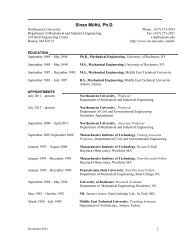An online ergonomic evaluator for 3D product design
An online ergonomic evaluator for 3D product design
An online ergonomic evaluator for 3D product design
You also want an ePaper? Increase the reach of your titles
YUMPU automatically turns print PDFs into web optimized ePapers that Google loves.
490<br />
The <strong>3D</strong> viewer—SpinFire TM plays an integral part<br />
in the proposed system. It does serve as a lightweight<br />
interface <strong>for</strong> the user to access <strong>3D</strong> data through the<br />
Internet. The API’s allow <strong>for</strong> easy customization and<br />
access to the Windows resources with JavaScript,<br />
C++, and Visual Basic. Coordinate trans<strong>for</strong>mation<br />
operations of translation, rotation, scaling, and their<br />
combination are also provided. These operations<br />
enable the user to manipulate <strong>3D</strong> objects interactively<br />
over the network, which is one major advantage that<br />
<strong>3D</strong> visualization technology has over other web-based<br />
multi-media tools. However, there are several limitations<br />
in the <strong>3D</strong> viewer used in the system. It requires<br />
installation of a browser plug-in <strong>for</strong> the first time use,<br />
which may cause a security concern in certain<br />
enterprise applications. <strong>An</strong>other bigger restriction of<br />
the current <strong>ergonomic</strong> <strong>evaluator</strong> is that it does not<br />
allow <strong>for</strong> change of the <strong>product</strong> geometry or<br />
engineering attributes. The user can only determine<br />
the <strong>product</strong> arrangement (the relative positions<br />
between parts in the above case) instead of full-scale<br />
customization, due to the limited functions of the<br />
viewer. All the available commercial viewers<br />
[21,22,43,44] are quite deficient in this category.<br />
5. Conclusions<br />
This paper has presented an <strong>online</strong> <strong>ergonomic</strong><br />
evaluation system <strong>for</strong> <strong>3D</strong> car interior <strong>design</strong> using<br />
web-based <strong>3D</strong> visualization technology. This system<br />
does not require advanced CAD tools or virtual reality<br />
facilities. It provides a virtual human in digital model<br />
that acts as the actual user and enables interactions<br />
with the <strong>product</strong>. This digital human is constructed<br />
with anthropometry data that characterizes the body<br />
shape and size at different levels <strong>for</strong> adults in Taiwan.<br />
Car interior <strong>design</strong> is used in this study <strong>for</strong><br />
demonstrating the feasibility of the proposed system.<br />
The user can adjust the car setting to fit the digital<br />
human through <strong>3D</strong> GUI’s embedded in a browser<br />
via the Internet. <strong>An</strong> <strong>ergonomic</strong> evaluation engine<br />
calculates the induced stresses and <strong>for</strong>ces corresponding<br />
to the posture created by the user. The calculation<br />
results are immediately prompted and help the user<br />
access the <strong>product</strong> <strong>design</strong> from the <strong>ergonomic</strong><br />
aspect. In this manner, the user can tailor the <strong>product</strong><br />
model according to individual preferences, and thus,<br />
C.-F. Kuo, C.-H. Chu / Computers in Industry 56 (2005) 479–492<br />
<strong>online</strong> <strong>product</strong> personalization is effectively achieved,<br />
both technologically and economically. Additionally,<br />
this work has demonstrated the potential of <strong>3D</strong><br />
visualization technologies in the Internet-based mass<br />
customization, linking the end-customer to <strong>product</strong><br />
<strong>design</strong>. They are applicable to other E-commerce<br />
activities, e.g. collection of marketing intelligences,<br />
customer relationship management (CRM), and<br />
customer-driven configuration to order (CTO).<br />
The <strong>ergonomic</strong> evaluation developed in this study<br />
is focused on biomechanical concerns. However,<br />
psychological factors also play an important role in<br />
evaluating a <strong>product</strong> and its acceptance by customers.<br />
More studies should be conducted on how to<br />
accomplish <strong>online</strong> psychological assessment <strong>for</strong><br />
consumer <strong>product</strong>s. In addition, the recent progress<br />
in <strong>for</strong>ce-feedback (haptic) devices brings up new<br />
opportunities <strong>for</strong> <strong>ergonomic</strong> evaluation. This technology<br />
enables on-line physical simulation that is likely<br />
to realize collaboratively distributed <strong>product</strong> assembly<br />
and testing. <strong>An</strong>other research worth of pursuing is to<br />
develop web-based <strong>3D</strong> visualization technologies that<br />
allow the user to modify <strong>product</strong> <strong>design</strong> over the<br />
network. This requires novel meshing techniques <strong>for</strong><br />
CAD models and advanced data structure <strong>for</strong><br />
integration of engineering attributes. Our future<br />
research is concerned with this topic.<br />
References<br />
[1] M. Baxter, Product Design, Chapman & Hall Publication,<br />
London, 1995.<br />
[2] R. Feyen, Y. Liu, D. Chaffin, G. Jimmerson, B. Josepg,<br />
Computer-aided <strong>ergonomic</strong>s: a case study of incorporating<br />
<strong>ergonomic</strong>s analyses into workplace <strong>design</strong>, Applied Ergonomics<br />
31 (2000) 291–300.<br />
[3] B. Kayis, P.A. Iskander, Three-dimensional human model <strong>for</strong><br />
the IBM/CATIA system, Applied Ergonomics 25 (6) (1994)<br />
395–397.<br />
[4] J. Rix, A. Heidger, C. Helmstadter, R. Quester, T. Ringhof,<br />
Integration of virtual human in CA <strong>design</strong> review, in: K.<br />
Landau (Ed.), Ergonomic Software Tools in Product and<br />
Workplace Design, IfAO Institut für Arbeitsorganisation,<br />
Stuttgart, Germany, 2000, pp. 183–194.<br />
[5] M. Launis, J. Lehtela, ErgoSHAPE: a <strong>design</strong> oriented <strong>ergonomic</strong><br />
tool <strong>for</strong> AutoCAD, in: M. Mattila, W. Karkowski (Eds.),<br />
Computer Applications in Ergonomics, Occupational Safety,<br />
and Health, Elsevier, Amsterdam, 1992, pp. 121–128.<br />
[6] J.W. McDaniel, Models <strong>for</strong> <strong>ergonomic</strong> analysis and <strong>design</strong>:<br />
COMBIMAN and CREW CHIEF, in: W. Karkowski, A.M.









